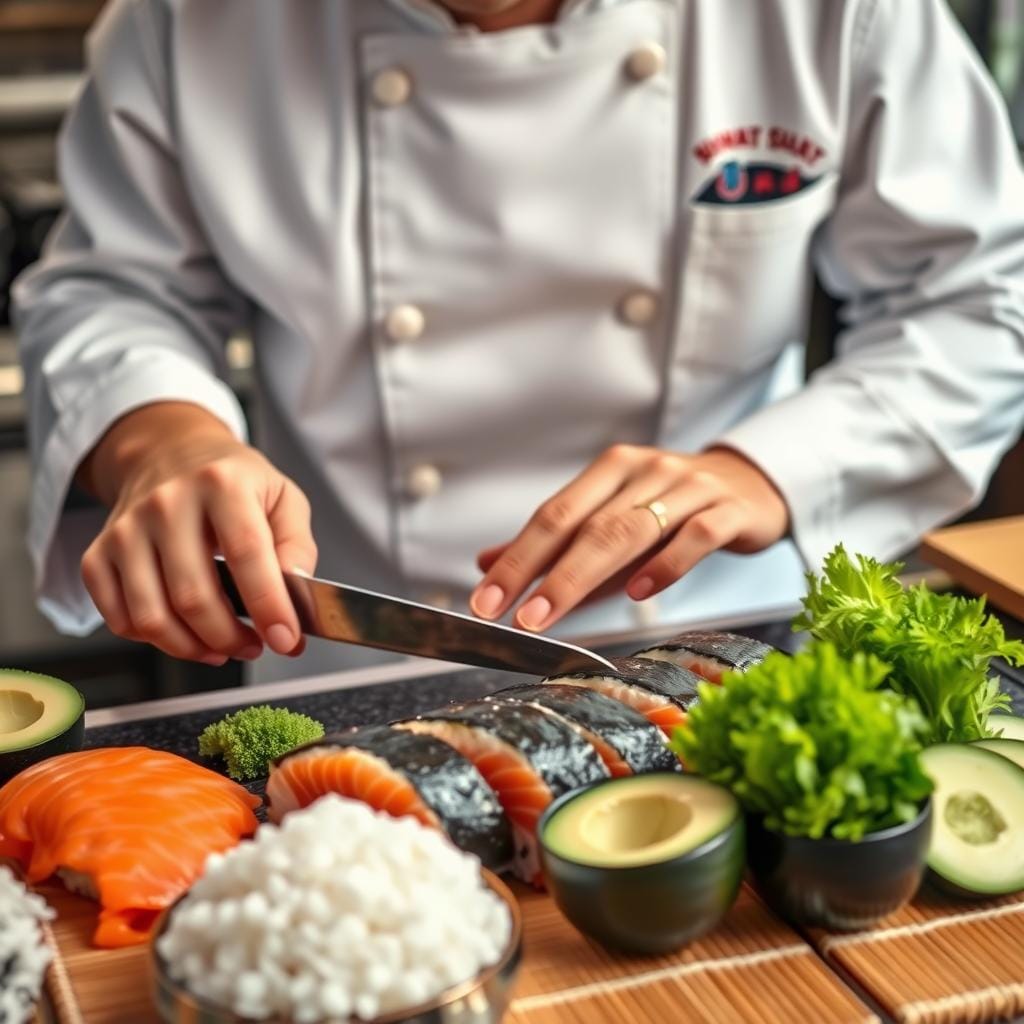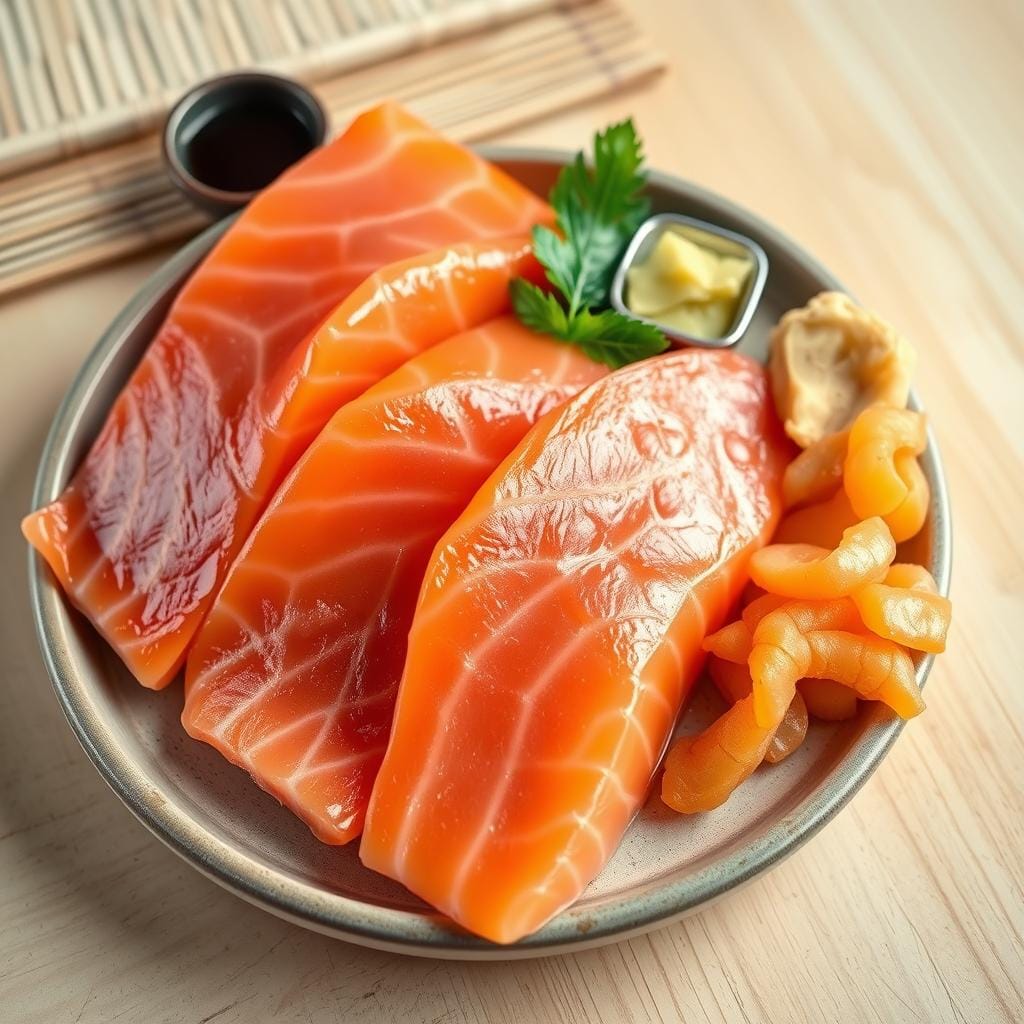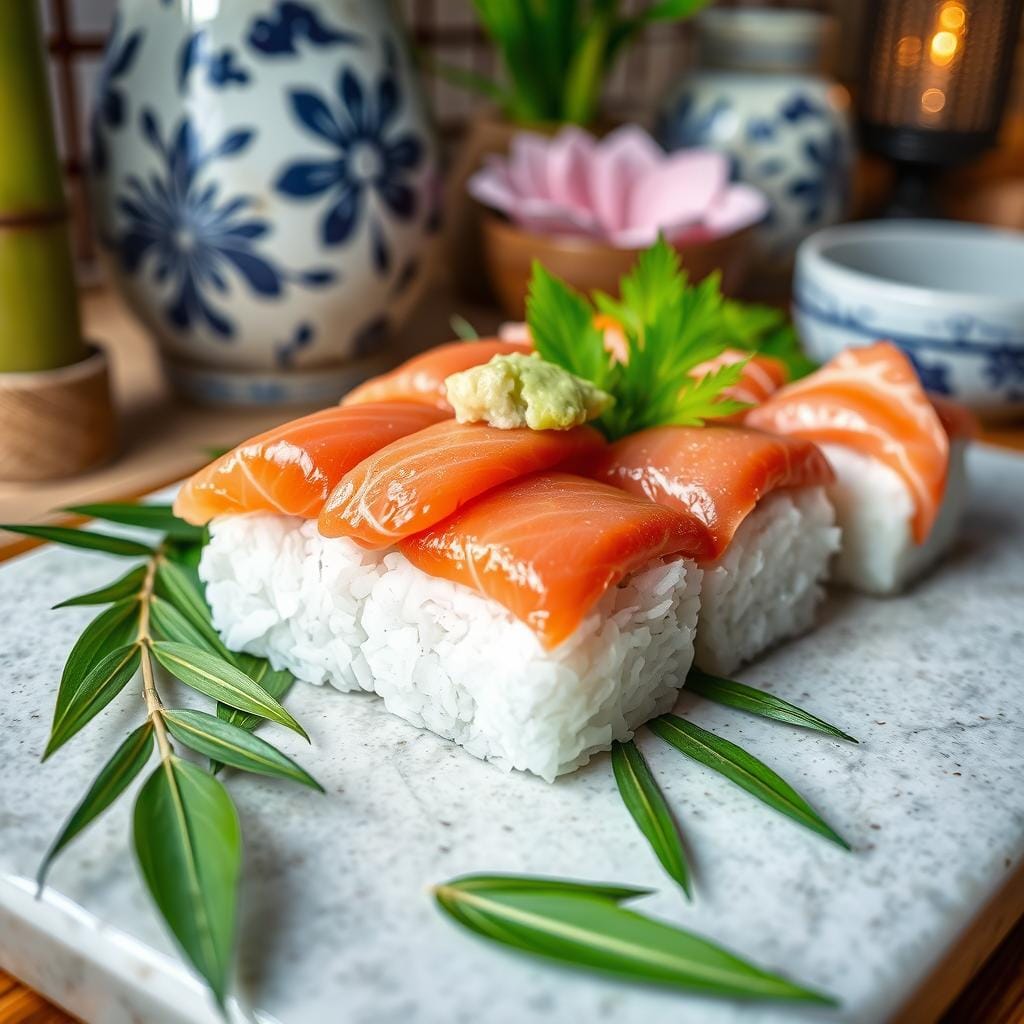salmon sushi, it felt magical. The delicate freshness of the fish melted in my mouth, instantly transporting me to the bustling streets of Tokyo. Japanese cuisine has a unique way of transforming simple ingredients into unforgettable culinary experiences.
Salmon sushi is more than food; it’s a cultural art. It brings people together through taste and tradition. Whether you love sushi or are new to it, exploring raw fish is a thrilling journey.
This guide will show you the world of salmon sushi. You’ll learn about choosing the best ingredients, mastering preparation, and the cultural history of this Japanese favorite.
Key Takeaways
- Salmon sushi is a celebrated culinary art form in Japanese cuisine
- Raw fish preparation requires precision and skill
- Understanding ingredient quality is crucial for authentic sushi
- Sushi represents both a meal and a cultural experience
- Proper techniques transform simple ingredients into extraordinary dishes
Understanding the Art of Salmon Sushi Making
Dive into the fascinating world of sushi, a culinary art form loved by many. Japanese cuisine is more than a meal; it’s a cultural experience. It combines precision, tradition, and flavor.

Salmon sushi has a rich history in Japanese culinary traditions. It started as a simple method to preserve fish and has become a global favorite. This delicacy has changed how people enjoy seafood.
History and Cultural Significance
Sushi began as a way to keep fish in fermented rice in the 8th century in Southeast Asia. Japanese chefs perfected this method, turning it into the art form we know today.
“Sushi is not just food, it’s an expression of culture and craftsmanship.” – Japanese Culinary Master
Traditional vs Modern Preparation Methods
- Traditional Method:
- Hand-pressed rice
- Minimal seasoning
- Strict knife techniques
- Modern Method:
- Advanced cutting tools
- Creative flavor combinations
- Experimental presentation
Essential Tools and Equipment
| Traditional Tool | Modern Equivalent | Purpose |
|---|---|---|
| Bamboo Mat | Professional Rolling Mat | Rice and Nori Rolling |
| Wooden Knife | High-Carbon Steel Knife | Fish Preparation |
| Clay Rice Cooker | Electric Rice Cooker | Perfect Rice Cooking |
Whether you’re a home cook or a professional chef, learning these techniques will improve your sushi-making skills. It will also deepen your appreciation for this traditional recipe.
The Perfect Salmon Selection for Your Sushi
Choosing the right salmon for sushi is an art. It can make your raw fish experience amazing. Quality and freshness are key for a great dining experience.

- Color and appearance of the raw fish
- Texture and firmness
- Sustainable sourcing
- Proper handling and storage
“The quality of your sushi begins with the quality of your fish” – Japanese Culinary Wisdom
Professional sushi chefs suggest certain salmon types for the best taste. Check out premium salmon cuts for a real taste experience.
| Salmon Type | Ideal Use | Flavor Profile |
|---|---|---|
| King Salmon | Sashimi | Rich, buttery |
| Sockeye Salmon | Nigiri | Robust, deep red |
| Atlantic Salmon | Maki Rolls | Mild, delicate |
Pro tip: Buy salmon from trusted fishmongers who sell sushi-grade fish. This ensures safety and flavor in your raw fish dishes.
Essential Ingredients for Authentic Salmon Sushi
Making great salmon sushi starts with choosing the right ingredients. You need to know the key parts that turn simple rice rolls into a gourmet dish.
Making sushi is all about precision and passion. Every ingredient is important for a true Japanese dining experience.
Premium Sushi Rice Selection
Rice is the base of any great sushi. Look for short-grain Japanese rice with these qualities:
- High starch content for perfect sticky texture
- Uniform white grains without imperfections
- Freshly harvested from premium rice-growing regions
Nori and Garnishing Elements
Seaweed wraps are key for traditional sushi rolls. Choose premium nori sheets that are:
- Dark green with a uniform color
- Crisp and not overly dry
- Free from visible tears or blemishes
“The quality of your nori can make or break your sushi experience.” – Japanese Culinary Master
Complementary Seasonings and Sauces
Enhance your salmon sushi with the right seasonings:
- Authentic wasabi paste
- High-quality soy sauce
- Rice vinegar
- Pickled ginger
Each ingredient adds to the complex flavors that make salmon sushi special.
Health Benefits of Raw Salmon in Japanese Cuisine
Raw salmon is a nutritional powerhouse in Japanese cuisine. It offers great health benefits. The fish is full of omega-3 fatty acids, which are good for your heart and brain. When you learn about traditional sushi preparation, you’ll see how raw fish is special.
Raw salmon has many healthy ingredients. These make it a great choice for your diet:
- High-quality protein for muscle maintenance
- Essential omega-3 fatty acids for heart health
- Vitamins D and B12 for energy metabolism
- Selenium for immune system support
Eating raw fish, like salmon, gives your body nutrients in their natural form. This is because it’s not cooked, so vitamins and minerals are kept better. Japanese cuisine values raw fish for a balanced diet.
“Fresh salmon represents nature’s most complete nutritional package” – Japanese Culinary Experts
Nutritionists say adding raw salmon to your diet is smart. It’s full of omega-3 fatty acids. These help lower inflammation, improve brain function, and may fight chronic diseases.
| Nutrient | Amount per 100g | Health Benefit |
|---|---|---|
| Omega-3 | 2.3g | Heart & Brain Health |
| Protein | 20g | Muscle Development |
| Vitamin D | 447 IU | Bone Strength |
Choose fresh, high-quality salmon for sushi to get the most health benefits. Your body will love this tasty and healthy choice.
Mastering Salmon Nigiri Preparation
Making perfect salmon nigiri needs skill and a love for Japanese food. This traditional sushi turns simple things into a feast for the eyes and taste buds.
Salmon nigiri making is a delicate art. It mixes technical skill with creative cooking. Start your journey to making real salmon sushi by learning key techniques.
Rice Molding Techniques
The first step is making the rice base right. You want a firm but soft rice shape that holds the salmon:
- Use short-grain sushi rice
- Wet hands with vinegar water to prevent sticking
- Gently press rice into an oval shape
- Maintain consistent rice density
Fish Cutting and Placement
Choosing and cutting the salmon is key for great nigiri. Here’s how to do it right:
- Select sashimi-grade salmon
- Use a sharp knife for precise cuts
- Slice against the grain
- Aim for uniform thickness
Presentation Tips
Make your salmon sushi look amazing with these tips:
| Technique | Description |
|---|---|
| Angle Placement | Position salmon at a slight angle for visual appeal |
| Garnish | Add a small wasabi between rice and fish |
| Plating | Use minimalist ceramic plates |
“Nigiri is not just food, it’s an expression of culinary art.” – Traditional Japanese Chef
Pro tip: Practice makes perfect when creating salmon nigiri. Each attempt brings you closer to mastering this intricate Japanese cuisine technique.
Creating Perfect Salmon Maki Rolls
Making delicious rice rolls needs skill and precision. Salmon sushi maki rolls are a tasty art that mixes fresh ingredients with skill. To start making real seaweed wraps, you must know the basic steps.
“Sushi making is a balance between technique and creativity” – Japanese Culinary Master
Creating salmon sushi maki rolls requires focus on a few key things:
- Select high-quality nori seaweed sheets
- Prepare perfectly seasoned sushi rice
- Choose fresh, sashimi-grade salmon
- Use sharp knife for precise cutting
The rolling process needs careful technique. Spread sushi rice evenly on the nori, leaving a small margin at the top. Place thin salmon strips to ensure balanced flavor in each bite.
| Ingredient | Quantity | Preparation |
|---|---|---|
| Sushi Rice | 1 cup | Sticky, room temperature |
| Nori Sheets | 1 sheet | Clean, unbroken |
| Salmon | 2-3 oz | Thinly sliced |
Pro tip: Use a bamboo mat for consistent, tight rolls that hold their shape perfectly.
Practice makes your salmon sushi look like a pro. Remember, patience and precision are key to mastering these tasty seaweed wraps.
Salmon Sashimi: The Pure Expression of Flavor
Salmon sashimi is the top of raw fish dishes in Japanese food. It shows the real taste of high-quality salmon. This is done without cooking.
Making great salmon sashimi needs skill and care for the ingredients. You start by learning the special ways to turn raw fish into a great meal.
Proper Cutting Techniques
Learning to cut sashimi well is all about knife skills. Chefs use certain rules to get the slices just right:
- Use a sharp yanagiba knife
- Cut against the fish grain
- Make slices about 1/8 inch thick
- Do smooth, single cuts
Temperature Control
Keeping the raw fish at the right temperature is key. For salmon sashimi, you need to handle it carefully:
| Temperature Range | Recommended Action |
|---|---|
| 32-40°F | Ideal storage temperature |
| 40-140°F | Potential bacterial growth zone |
| Just above freezing | Perfect serving temperature |
Plating Aesthetics
How you present sashimi makes it more than just food. Follow these plating tips:
- Use simple white plates
- Arrange salmon slices in patterns
- Add microgreens or edible flowers
- Include wasabi and pickled ginger
“In sashimi, simplicity is the ultimate sophistication.” – Japanese Culinary Proverb
Your salmon sashimi journey is about enjoying raw fish’s true taste. This is done through careful making and beautiful presentation.
Food Safety Guidelines for Raw Fish Preparation
Preparing raw fish for sushi needs careful attention to food safety. Your health depends on knowing how to handle raw fish safely. This prevents foodborne illnesses.
“Fresh, safe raw fish is the foundation of exceptional salmon sushi” – Culinary Expert
Temperature control is key when working with raw fish. Raw salmon must be kept at specific temperatures. This minimizes bacterial growth and ensures safe consumption of your healthy ingredients.
- Maintain fish at 40°F or below before preparation
- Use clean, sanitized cutting surfaces
- Purchase salmon from reputable seafood suppliers
- Check for freshness and high-quality appearance
Proper handling techniques are essential for salmon sushi preparation. Always use separate cutting boards for raw fish and other ingredients. This prevents cross-contamination.
| Safety Parameter | Recommended Practice |
|---|---|
| Storage Temperature | 32-38°F (0-3°C) |
| Maximum Storage Time | 1-2 days |
| Recommended Freezing | -4°F (-20°C) for 7 days |
Professional chefs suggest freezing raw fish before preparation. This step is crucial for ensuring the safety of your salmon sushi. It also helps keep its delicate flavor and texture.
Remember: Food safety is not optional when preparing raw fish – it’s mandatory for a delicious and risk-free dining experience.
Pairing Suggestions for Your Salmon Sushi Experience
Enhancing your sushi experience is more than just the fish. The right drink and side dishes can make your Japanese food journey unforgettable.
Traditional Beverage Companions
Choosing the perfect drink for salmon sushi is key in Japanese cuisine. Sake is a top pick for many. You can choose:
- Chilled Junmai sake for delicate salmon flavors
- Warm Honjozo sake with richer salmon preparations
- Green tea as a refreshing alternative
Complementary Side Dishes
Adding the right side dishes makes your salmon sushi experience even better. Here are some great options:
- Edamame with sea salt
- Pickled cucumber salad
- Miso soup
“The art of sushi is not just in the fish, but in the harmony of flavors surrounding it.” – Japanese Culinary Wisdom
Try out these pairings to find your favorite salmon sushi combo. Each part adds to a rich, authentic dining experience that honors Japanese food traditions.
Storage and Freshness Tips for Salmon Sushi
Keeping your raw fish and salmon sushi fresh is key. Salmon sushi is a delicate part of Japanese cuisine. It needs careful handling to keep its great taste and safety.
“Proper storage is the key to enjoying salmon sushi at its peak flavor and nutritional value.”
Temperature control is crucial when storing raw fish for sushi. Your fridge should be between 32-38°F. This stops bacteria from growing and keeps the sushi fresh. Eat your sushi within 24 hours for the best taste and safety.
- Store salmon sushi in airtight containers
- Keep raw fish separate from other foods
- Use clean utensils when handling
- Check freshness before consumption
Look out for signs of spoilage in raw fish. These include color changes, a slimy feel, and bad smells. Always check the quality of your salmon sushi preparation before eating. Refrigeration slows down bacterial growth but doesn’t stop it.
Experts say to buy sushi-grade salmon from trusted places and eat it fast. Fresh is always best for enjoying this tasty Japanese dish.
Conclusion
Salmon sushi is more than a meal; it’s a celebration of Japanese cuisine. It shows the skill, tradition, and passion in every bite. From picking the best fish to cutting it just right, salmon sushi shows respect for ingredients and technique.
Learning about salmon sushi takes you on a journey through centuries of cooking. It’s a path of patience, practice, and love for Japanese cooking. Whether you cook at home or love food, these skills can make your kitchen creative.
Now, you see salmon sushi as a cultural experience. Each piece tells a story of tradition, skill, and taste. As you keep exploring and practicing, remember it’s a journey that connects you to a rich culinary heritage.
Enjoy the art, the flavors, and your salmon sushi journey. Do it with confidence and curiosity.

